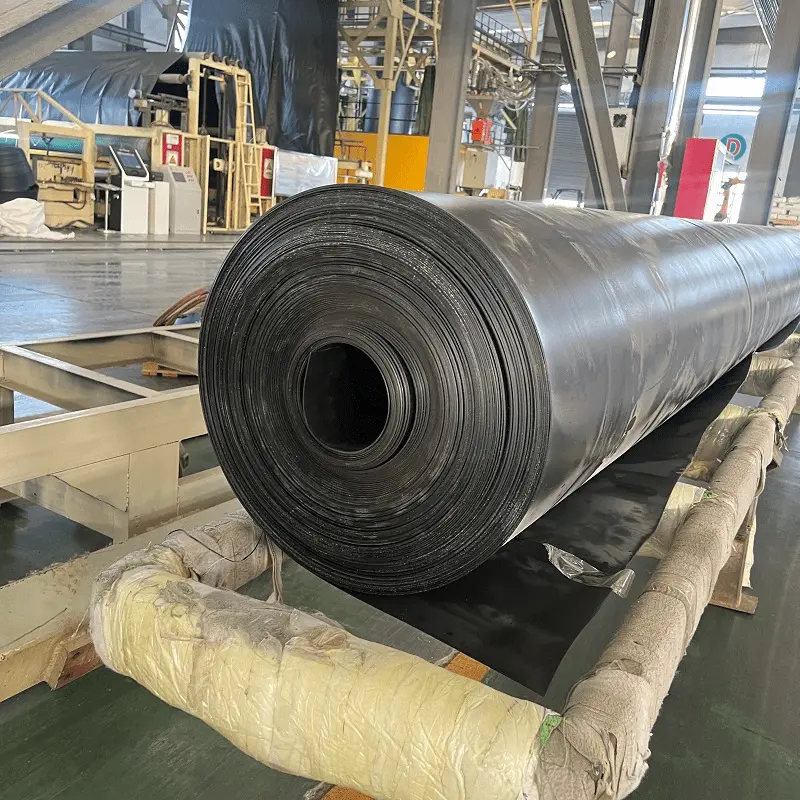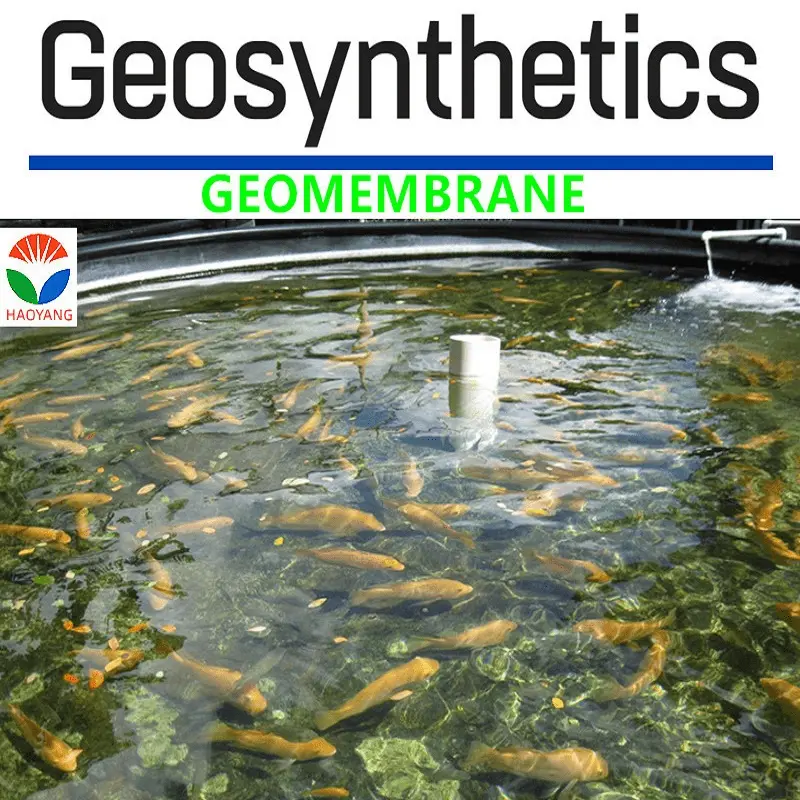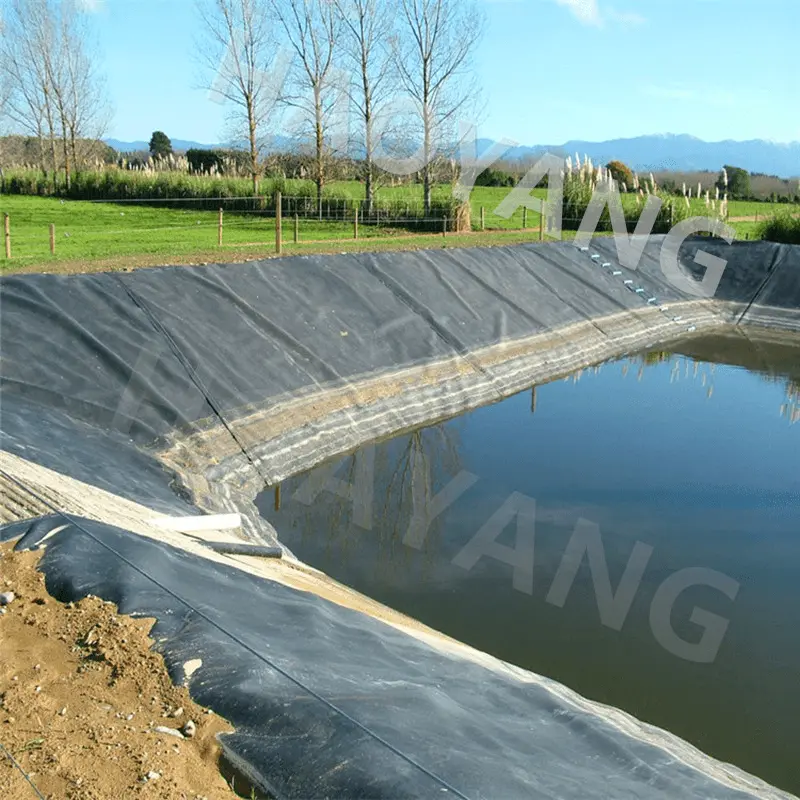I. Basic Characteristics of 0.75mm Geomembrane
0.75mm geomembrane is a high-density polyethylene (HDPE) anti-seepage membrane with excellent physical and chemical properties. Its main characteristics are as follows:
Thickness: 0.75mm, which provides sufficient strength and durability while controlling costs.
Density: 0.94g/cm³, the high-density polyethylene material gives the geomembrane good tear and puncture resistance.
Tensile Strength: Yield strength of 10N/mm, breaking strength of 15N/mm, and elongation at break of 600%, ensuring the stability of the geomembrane under various external forces.
Anti-seepage Performance: With an extremely low permeability coefficient, it effectively prevents water seepage and maintains stable pond water levels.
Weather Resistance: Passed the low-temperature impact brittleness test at -70℃, suitable for the varied climatic conditions in Mexico.

II. Application of 0.75mm Geomembrane in Mexican Ponds
1. Pond Anti-seepage
The pond aquaculture industry in Mexico is mostly located in areas with high rainfall, so anti-seepage is a critical aspect of pond construction. 0.75mm geomembrane, with its excellent anti-seepage performance, has become the preferred material for pond anti-seepage. By laying the geomembrane, it can effectively prevent pond water from infiltrating the soil, maintain stable water levels, and thus improve aquaculture efficiency.
2. Water Quality Protection
The quality of pond water directly affects the growth and yield of aquatic organisms. 0.75mm geomembrane not only prevents water seepage but also reduces changes in water quality conditions, lowering the cost and time required for water quality control. Additionally, the geomembrane effectively isolates harmful substances in the soil, maintaining clean and stable water quality.
3. Monitoring and Management
In pond aquaculture, dissolved oxygen content is an important factor affecting the growth of aquatic organisms. The laying of 0.75mm geomembrane reduces oxygen loss due to infiltration into the soil, facilitating monitoring of dissolved oxygen levels in the water and timely adjustment of aquaculture strategies. Furthermore, the geomembrane stabilizes slopes, eliminating natural threats to the pond and enhancing its safety.

III. Benefit Analysis of 0.75mm Geomembrane in Mexican Ponds
To intuitively demonstrate the benefits of 0.75mm geomembrane in Mexican ponds, the following table lists comparison data before and after its application:
| Indicator | Before Geomembrane Application | After Geomembrane Application |
|---|---|---|
| Water Level Stability | Large fluctuations, frequent water replenishment required | Stable, reduced water replenishment frequency |
| Water Quality Changes | Frequent fluctuations, difficult to control | Stable, easy to maintain |
| Dissolved Oxygen Content | Difficult to monitor, large fluctuations | Easy to monitor, stable |
| Growth Rate of Aquatic Organisms | Slow, greatly affected by water quality | Faster, stable growth environment |
| Disease Incidence of Aquatic Organisms | High, affected by water pollution | Lower, clean water quality |
| Harvest Efficiency | Lower, weeds and sludge on the pond bottom | Higher, clean pond bottom without debris |
| Maintenance Cost | Higher, frequent pond cleaning required | Lower, easy to clean and maintain |
From the table, it can be seen that the application of 0.75mm geomembrane significantly improves the benefits of pond aquaculture. Water level stability increases, reducing the number of water replenishments; water quality remains stable and easy to maintain; dissolved oxygen content is easy to monitor, providing a good growth environment for aquatic organisms; growth rates of aquatic organisms accelerate, and disease incidence decreases; harvest efficiency improves, and maintenance costs decrease.
IV. Laying and Construction of 0.75mm Geomembrane in Mexican Ponds
1. Preparation Before Laying
Before laying the 0.75mm geomembrane, the pond bottom needs to be compacted and leveled to ensure a flat and even surface. Additionally, drainage blind ditches should be dug to remove accumulated water after laying the geomembrane.
2. Laying Techniques
When laying the geomembrane, it is important to avoid wrinkles and bulges. For irregular pond shapes, the geomembrane can be laid along the perpendicular direction of the axis to ensure a flat and tightly adhering surface. During the laying process, special tools should be used to compact the geomembrane to ensure it is tightly bonded to the bottom.
3. Welding and Seam Treatment
Seam treatment is a critical aspect of ensuring the anti-seepage performance of 0.75mm geomembrane. Hot-melt welding equipment is generally used for seam treatment to ensure high seam strength and good sealing performance. During the welding process, it is important to control the welding temperature and speed to avoid cracks or poor welding connections.
4. Construction Precautions
During geomembrane construction, attention should be paid to the impact of climatic conditions on construction quality. The temperature should generally be between 5 and 40 degrees Celsius. The geomembrane should be properly tensioned at low temperatures. Additionally, construction should be avoided in adverse weather conditions such as winds above force 4 or rainy days to prevent affecting the laying quality and anti-seepage performance of the geomembrane.
V. Case Study of 0.75mm Geomembrane Application in Mexican Ponds
Here is a successful case of a Mexican pond using 0.75mm geomembrane:
Cathy, an aquaculturist in a region of Mexico, owns a 500-square-meter pond. Previously, due to poor anti-seepage performance, the water level often fluctuated, resulting in slow growth and frequent diseases among aquatic organisms. To improve this situation, Cathy decided to lay 0.75mm geomembrane in the pond. After careful construction and subsequent maintenance, the pond's anti-seepage performance significantly improved. The water level remained stable, and the water quality was clean and easy to maintain. The growth rate of aquatic organisms increased significantly, and disease incidence decreased. Cathy's pond aquaculture benefits improved notably, making him a leader in the local pond aquaculture industry.
VI. Conclusion
In summary, the application of 0.75mm geomembrane in Mexican ponds has significant advantages and benefits. By laying the geomembrane, the pond's anti-seepage performance and water quality stability can be effectively improved, providing a good growth environment for aquatic organisms. Additionally, the application of geomembrane reduces maintenance costs and improves harvest efficiency, bringing considerable economic benefits to aquaculturists. Therefore, 0.75mm geomembrane has broad application prospects and promotion value in the Mexican pond aquaculture industry.
In future developments, the Mexican pond aquaculture industry will continue to move towards efficiency, environmental protection, and sustainability. As an important anti-seepage material, 0.75mm geomembrane will play an increasingly important role in this process. By continuously improving and refining construction techniques and technological means, the application effect and service life of geomembrane will be further enhanced, contributing significantly to the prosperous development of the Mexican pond aquaculture industry.
![]() 1.5 Double-sided smooth HDPE geomembrane.pdf
1.5 Double-sided smooth HDPE geomembrane.pdf



897.webp)
942.webp)
237.webp)